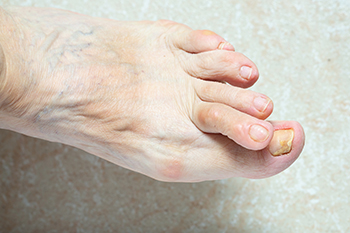
Overlapping toes, a condition where one toe rests on top of another, affects people of all ages, from newborns to adults. Causes include heredity, tight-fitting shoes, arthritis, and biomechanical issues. Underlying foot conditions, like bunions, flat feet, hammer toes, or high arches, can also contribute to developing overlapping toes. In newborns, this condition may result from heredity or the positioning of the baby in the womb. Gentle measures such as taping the toes or using toe spacers are effective for newborns, while adults can benefit from conservative methods like wearing properly fitting shoes and maintaining a healthy weight. If conservative treatments fail, surgery may be necessary, especially for severe cases or when a bunion is involved. Early intervention is key to preventing long-term complications. For help in managing problems related to overlapping toes, it is suggested that you schedule an appointment with a podiatrist for an accurate diagnosis and treatment options.
Toe pain can disrupt your daily activities. If you have any concerns, contact Dr. Dean D. Hinners of Illinois. Our doctor can provide the care you need to keep you pain-free and on your feet.
What Causes Toe Pain?
Most severe toe pain is caused due to a sports injury, trauma from dropping something heavy on the toe, or bumping into something rigid. Other problems can develop over time for various reasons.
Toe pain can be caused by one or more ailments. The most common include:
- Trauma
- Sports injury
- Wearing shoes that are too tight
- Arthritis
- Gout
- Corns and calluses
- Hammertoe
- Bunions
- Blisters
- Ingrown toenails
- Sprains
- Fractures (broken bones)
- Dislocations
When to See a Podiatrist
- Severe pain
- Persistent pain that lasts more than a week
- Signs of infection
- Continued swelling
- Pain that prevents walking
Diagnosis
In many cases the cause of toe pain is obvious, but in others, a podiatrist may want to use more advanced methods to determine the problem. These can range from simple visual inspections and sensation tests to X-rays and MRI scans. Prior medical history, family medical history, and any recent physical traumatic events will all be taken into consideration for a proper diagnosis.
Treatment
Treatments for toe pain and injuries vary and may include shoe inserts, padding, taping, medicines, injections, and in some cases, surgery. If you believe that you have broken a toe, please see a podiatrist as soon as possible.
If you have any questions please feel free to contact one of our offices located in Metropolis and Eldorado, IL . We offer the newest diagnostic tools and technology to treat your foot and ankle needs.
